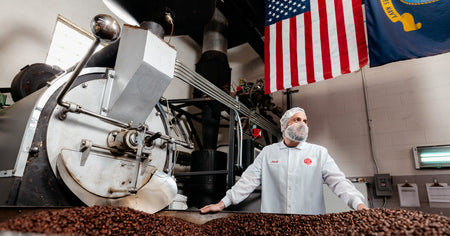November 18, 2020
Famous for its timeless design that earned it a place in a MoMA collection, the Chemex is the undisputed star amongst manual pour overs.
As well as being an elegant coffee maker to showcase on your countertop, it guarantees smooth cups of delicious java.
That’s only if you know how to make Chemex coffee like an experienced barista, though! That’s ok: we’re going to show you.
Chemex brewing guide: how to make Chemex coffee that tastes as good as it looks
You’ll need your Chemex, a Chemex filter, coffee and water (duh), a gooseneck kettle, a timer and a coffee scale (trust us!). Our recipe is best suited for the standard 6-cup Chemex, but you can easily tweak it to fit your 3, 8 or 10-cup model by using a different 1:15 coffee-to-water ratio.

Have the right coffee
Use a burr grinder to grind 45g of coffee to a medium-coarse size, sort of like sea-salt.
Get the right hot water temperature
Don't scorch your grounds! Aim for 195-205°F (90-96°C). If you haven’t got a variable-temperature kettle or a thermometer, boil the water before grinding the coffee beans, so that it’s cooled down slightly by the time you pour it.
Pre-wet the filter
Place the filter on top of the Chemex and pre-wet it to avoid a papery taste. You can now discard that water and add your grounds.
Pulse-pour
Place the Chemex onto the scale, tare it, and start the timer. Gently, working your way around the middle but avoiding the edges, pour 90g of water (or twice the amount than you have coffee). Ensure an even extraction by letting your grounds bloom for around 30 seconds.
Go back to pulse-pouring, but this time spread it over increments of roughly 200g: they should take around 30 seconds each, with an extra 30 seconds in-between. Stop pouring when you reach 700g, which should be at around 3/3.30min. Then let the water drip.

Enjoy it
Remove the filter, give your Chemex a swirl to aerate the coffee, and drink it, as its glass walls won’t keep it piping hot for too long. Some people place it on a low heat on their stovetop, but this can stew the coffee and result in over-extraction, so it’s better to drink it just after brewing it (why would you want to wait, anyway?).
Avoiding under-extraction and over-extraction when brewing Chemex coffee
If your Chemex coffee tastes sour and weak, it’s under-extracted: try a slightly finer grind, less water compared to the amount of coffee, or a slightly higher temperature.
If it tastes bitter and burnt, it’s over-extracted: try a coarser ground, having a little less coffee compared to the water, or having the latter at a slightly lower temperature.

Is Chemex better than French press?
We hear this question a lot, but Chemex and French presses aren’t one better than the other: they’re separate brewing methods that can appeal to different palates! The former is one of the best pour over methods and, like most of them, it involves pulse-pouring techniques and a bit of a learning curve; thanks to its paper filters, it also guarantees a sediment-free brew. French presses, on the other hand, are the most popular immersion-brewing method: they’re quick, easy to use, and result in a more robust coffee.
Now that you know how to make Chemex coffee like a professional barista, you’ll no longer need to worry about under- or over-extraction: just make sure that you’ve got the freshest coffee and start making everyone jealous of your impeccable pulse-pouring skills!
Leave a comment
Comments will be approved before showing up.
Also in Fire Department Coffee News

Standing with Laurel County After an EF4 Tornado

FDC Featured In Nationwide Walmart Commercial and Celebrates Community Roots in Rockford

Rescue-1 Deploys to Texas: Fire Department Coffee Supports Communities After Catastrophic Flooding

Celebrating America’s Firefighting Presidents

Fire Department Coffee and Kidde Working Together to Promote Fire Safety

From Barista to Coffee Expert: Fire Dept. Coffee's Jacob Ball Brews Success

Get to Know the Hilarious, Hardworking Team Behind FDC Videos

From Fan to Family: How Lance Woodruff Became an FDC Star

Marine, Musician, Firefighter: Josh Kennedy is Doing It All

FDC Mobilizes Rosenbauer Fire Truck for Tennessee Tornado Relief

Fire Dept. Coffee's First Retail Shop Opens in Rockford, IL

Sugar Cookie Rum Infused Coffee - Spirit Infused Coffee Club
FOLLOW OUR JOURNEY, GET SPECIAL OFFERS AND PROMOTIONS
- SPIRIT INFUSED COFFEE
- Bourbon Infused Coffee
- Whiskey Infused Coffee
- Rum Infused Coffee
- Spirit Infused Coffee Club
- Spirit Infusion Process
GEAR
© 2025 Fire Department Coffee, Inc.











